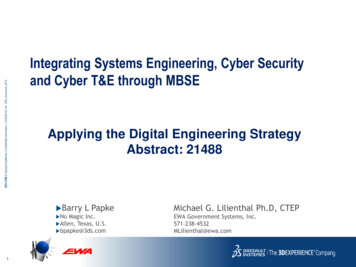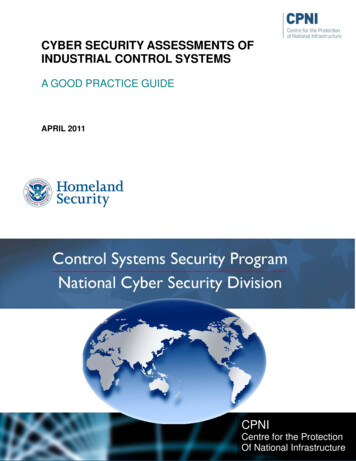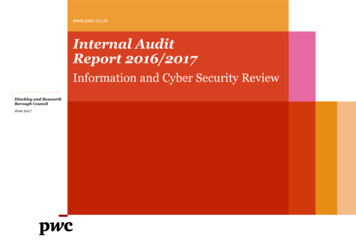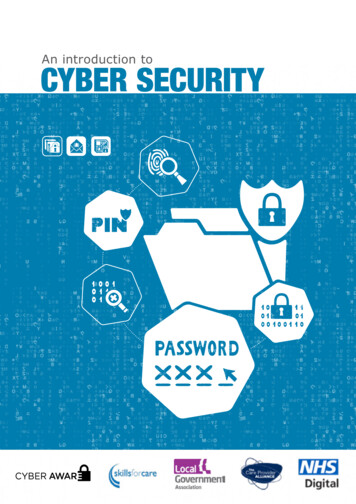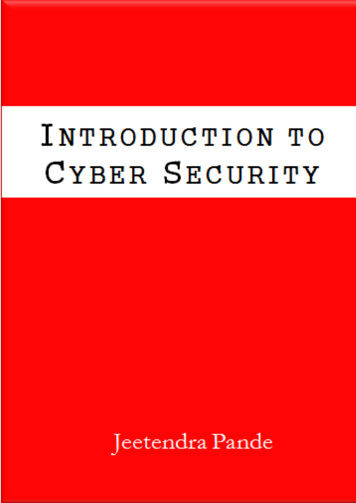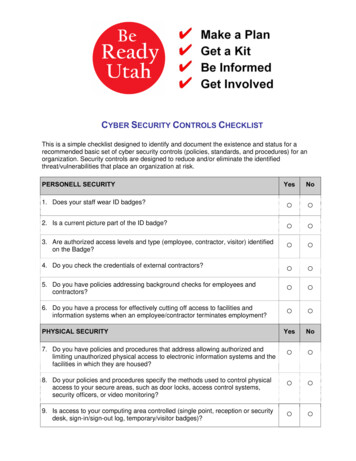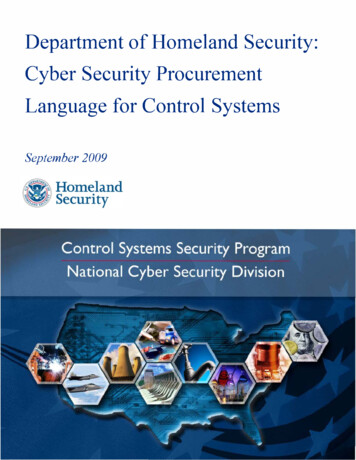
Transcription
Department of Homeland Security:Cyber Security ProcurementLanguage for Control SystemsSeptember 2009
FOREWORDA key component in protecting a nation’s critical infrastructure and keyresources (CIKR) is the security of control systems.WHAT ARE CONTROL SYSTEMS?Supervisory Control and Data Acquisition (SCADA), Process ControlSystem (PCS), Distributed Control System (DCS), etc. generally refer to thesystems which control, monitor, and manage the nation’s critical infrastructuressuch as electric power generators, subway systems, dams, telecommunicationsystems, natural gas pipelines, and many others. Simply stated, a control systemgathers information and then performs a function based on establishedparameters and/or information it received.For example, a control system might gather information pertaining to a leakin a pipeline. The system would then transfer the information back to a centralsite alerting a control station that the leak has occurred, carrying out necessaryanalysis and control such as determining if the leak is impacting operations anddisplaying the information in a logical and organized fashion. In this example,shutting down the pipeline is one of the functions that the control system couldperform if a leak is detected.Control systems can be relatively simple, such as one that monitorsenvironmental conditions of a small office building, or incredibly complex, suchas a system that monitors all the activity in a nuclear power plant or the activityof a municipal water system.Because the function control systems perform for the continuous and safeoperation of the nation’s critical infrastructures, it is essential to recognize andunderstand the important roles these systems play. In addition, there should be aheightened interest in recognizing the potential vulnerabilities, consequences, andchallenges in securing these systems from compromise.One example of the challenges presented was the recent disclosure of aSCADA system compromise, which was responsible for controlling a localgovernment’s municipal water supply. This example highlights the need to focuscyber security efforts and the importance of critical infrastructure. SCADAsecurity is an emerging issue, which can no longer be ignored. Stakeholdereducation is also a critical factor for success when addressing the need for controlsystems cyber security. The U.S. Department of Homeland Security recognizesthe importance of control systems security education and awareness and offersthe Cyber Security Procurement Language document as a means to help assetowners integrate security into their control systems security lifecycle.WHY SHOULD WE BE CONCERNED?Control system technology has evolved over the past 30 years as a method ofmonitoring and controlling industrial processes. Control systems were first usedin the 1960s to control and monitor events that were performed by humans.Industry trends have demonstrated that the life cycle of a control system is nowbetween 15 and 30 years.iii
Thirty years, or even 15 years ago, security was not generally a priority in thecontrol systems environment. Traditionally, control systems were stand-alonedevices, not connected to business networks or the outside world via the Internet.Over the years, these systems have gone from proprietary, stand-alonesystems, to those that use commercial off-the-shelf (COTS) hardware andsoftware components. With the increase of more commonly used hardware andsoftware, comes the potential for information technology (IT) vulnerabilities tobe exploited within the control systems environment.The Symantec Internet Security Threat Report issued in September 2006adocumented nearly 7,000 new worms and viruses, and more than 2,200 newvulnerabilities in the first half of 2006; this is the highest number ever recordedfor a 6-month period. In the past, software fixes were available months beforeattackers would exploit the vulnerabilities with fast spreading worms such asSlammer or Nimda. The trend has been reversed; software vulnerabilities areroutinely exploited before the vulnerabilities are fully understood or protectionmechanisms are identified.Not all SCADA systems are vulnerable or are at risk of attacks. However,these systems manage critical infrastructure assets that are vital to a nation’seconomy. Whether the threats are real or perceived, it is in a nation’s interest toprovide guidance on the protection of these assets.In March 2004, the U.S. Government Accountability Office (GAO)published a report on SCADA security a that it produced at the request of the U.S.House Committee on Government Reform Subcommittee on Technology andInformation Policy. That report focused, in part, on why the risk to controlsystems is increasing.The report listed the four contributing factors to the escalation of risk toSCADA systems:a.1.Control systems are adopting standardized technologies with knownvulnerabilities2.Control systems are connected to other networks that are not secure3.Insecure connections exacerbate vulnerabilities4.Manuals on how to use SCADA systems are publicly available to theterrorists as well as to legitimate users.GAO, “Challenges and Efforts to Secure Control Systems,” March 2004.iv
BACKGROUNDThe U.S. Department of Homeland Security Control Systems SecurityProgram, Idaho National Laboratory, Chief Information Security Officer of NewYork State, and the SANS Institute have established an initiative to bring publicand private sector entities together to improve the security of control systems.The goal is for private and public asset owners and regulators to come togetherand adopt procurement language that will help ensure security integration incontrol systems.The Cyber Security Procurement Language for Control Systems effort wasestablished in March 2006. The results of this endeavor represent the joint effortof the public and private sectors focused on the development of commonprocurement language for use by all control systems stakeholders. The goal is forfederal, state, and local asset owners and regulators to obtain a common controlsystems security understanding; using these procurement guidelines will helpfoster this understanding and lead to integration of security into control systems.The Cyber Security Procurement Language Project Workgroup comprises242 public and private sector entities from around the world representing assetowners, operators, and regulators. In addition, over 20 vendors participate in aworking group to assist in reviewing and producing the procurement language.Comments on this document are welcome and should be submitted tocssp@dhs.gov with the subject line of “Procurement Project.”This document provides information and specific examples of procurementlanguage text to assist the control systems community, both owners andintegrators, in establishing sufficient control systems security controls withincontract relationships to ensure an acceptable level of risk.v
vi
SECURITY OBJECTIVESA discussion of security objectives is provided as a framework toestablishing security controls within the context of control systems procurement.A common understanding of security objectives is required to facilitatecomprehensive controls necessary to operate at an acceptable level of risk.There are three security objective categories as defined in traditionalinformation assurance areas: Availability, Integrity, and Confidentiality. bSCADA and control systems must be available continuously when controllingcritical infrastructure or life-safety systems. A control systems operator must relyon the integrity of the information in order to take appropriate actions based onthe readings or status of the system. Confidentiality is not as important becausemost of the information used and transmitted is state-based and only valid forthat specific time. For example, the set point for a process is only valid until thenext set point is sent, which may be as short as a second. Contrast that to thetraditional IT world where a credit card number is valid for many years. Fortraditional IT systems, integrity assumes authentication, authorization, and accesscontrol based on the decades of implementation of role-based access control(RBAC). This is not the case for legacy control systems where the use of RBACis rare. For this reason, Authentication, Authorization, and Access Control willbe discussed under the Integrity section. Nonrepudiation is important for selectedindustry segments that use data from control systems and SCADA for financialmarkets (see the Confidentiality section for more information).AvailabilityAvailability is defined as providing the data when needed or “ensuring timelyand reliable access to and use of information .” c A loss of availability is thedisruption of access to or use of information from an information system.Availability is of the highest priority for control systems and SCADAenvironments due to the near real-time nature of these applications. SimpleDenial of Service (DoS) type of IT attacks applied to a control system will havelarge impacts because of the importance of control and monitoring functionswithin a control systems environment.The timeliness of data being sent or received from control systems isparamount. The control system operator needs assurance that the data being sentor received are true. These two requirements inherently require that a highpriority be given to meeting the availability and integrity objectives for controlsystems.The availability objective has differing importance across large integratedsystems that use SCADA or control system data. Enterprise level managementsystems generally require a medium availability, while control systems requirehigh availability. The outage of a management system will not result in the lossof control, but of situational awareness that may or may not result in a systemfailure. Because the failure of a control system could result in significant impactb.c.FIPS PUB 199, “Standards for Security Categorization of Federal Information and Information Systems,” FederalInformation Processing Standards, December 2003.44 United States Code, Section 3542.vii
or consequence, over engineering and redundant features are used to ensure thehigh rate of availability.Basic protections need to be in place to prevent random nontargeted IT-basedattacks from impacting the control systems environment. On the other side,security measures implemented cannot impact the availability of a system. Forexample, an anomaly-based network intrusion detection system (NIDS) is notrecommended for a network whose communication method is to report byexception when the system normally has events that cause all devices to report atthe same time (e.g., severe weather in the electrical sector). Thus, added securitymeasures should be tested in abnormal conditions to ensure that availability hasnot been impacted and should be able to be removed quickly, if necessary, toensure continued operations.IntegrityIntegrity is ensuring that the data presented are the true valid master sourceof the data or “guarding against improper information modification or destructionand includes ensuring information nonrepudiation and authenticity.” d A loss ofintegrity is the unauthorized modification, insertion, or destruction ofinformation. The underlying mechanisms that normally aid in the integrity of asystem are missing or weak in control systems (reference the sections onauthentication and authorization). False data displayed on the human-machineinterface or sent to applications or remote field devices could result in systemfailure. Also, alterations in the applications (programs and memory) could affectthe integrity or availability of the system.Access control, authentication, and authorization are specifically discussedfor integrity since control systems do not have a 20-year history of applyingpasswords, accounts, and role-based permissions to these applications such as inthe IT community. Because of the lack of role-based permissions, some uniqueworkarounds have been implemented to support the control system environment.A large part of the access control objective is physical. All the required cybersecurity layers will fail if the attacker has physical access to the systems.Access control is making the data/application/communication available toonly those with permission. Loss of access control allows unauthorized entry intoa system. If role-based permissions do not exist, the breach in access control mayresult in a loss of confidentiality, integrity, and system availability. For thisreason, access control is included as a security objective. Moreover, when controlsystem assets are located in remote, geographically dispersed areas, accesscontrol is particularly challenging.Authentication is ensuring that entities verify that they are who they claim tobe and are not malicious spoofing authorized identities. Authentication isimportant when an entity first attempts to gain access to a system or application.There are four authentication factors: “what you know” (i.e., username andpassword), “what you have” (i.e., key, digital certificates, and smart cards),“what you are” (i.e., biometric scan such as fingerprints and iris recognition), and“what you do” (i.e., dynamic biometrics such as hand writing and voiced.44 United States Code, Section 3542.viii
recognition). The more detailed privileged rights are discussed in theAuthorization section. A loss of authentication could lead to a loss ofconfidentiality, integrity, and system availability. Authentication is normallyhandled by checks in protocols or by account and password functions, and isincluded in the integrity security objective in traditional IT-based systems. This isincluded as a security objective because most control systems and protocols thatsupport those systems have weak or no authentication.Authentication is a unique challenge in the control system environment sincethe initiating sources could be processes, applications, or information on a fielddevice. Hardware authentication can be done via static addressing, or passingkeys or certificates. Adhering to static addressing and enforcing hardwareauthentication for network access is one layer of added security that bypasses allthe domain name server-type of exploits. Authorization also has a uniqueperspective in the control system environment because the entity could beanother process or communication link.Authorization is granting a user, program, or process the right of limitedcontrol once authentication has been determined. This ensures that the entity ispermitted to perform the read, write, delete, and update functions, or execution ofa task, which is normally managed by role-based permissions. A breakdown ofrole-based restrictions may result in an entity that has access to the systemgaining the ability to run processes and control the system above their permissionlevel. In the traditional IT world, role-based permissions are implemented andnormally linked to an account password authentication task and permission tablesfor applications. However, most legacy control systems are not designed forrole-based permissions.The code resident in memory in the remote field devices is also subject tointegrity concerns that include authentication, authorization, and access control.This code controls the remote device’s actions during normal communications tothe control system and during times when communication to the larger controlsystem or SCADA is not available. Most of this “code” appears like actual data.A trend includes resident memory for nonrepudiation checks to ensure that thecode has not been changed since its last installation.Other solutions to maintain integrity may include one or more of thefollowing: deep packet inspection of data, sequence numbers in proprietaryprotocols, checksums in protocols, and host-based intrusion detection systems(IDSs) that record changed, stored, or running applications.ConfidentialityConfidentiality means keeping the data unseen by others, or “preservingauthorized restrictions on information access and disclosure, including means forprotecting personal privacy and proprietary information.” e A loss ofconfidentiality is the unauthorized disclosure of information.Attackers can identify account names and passwords if transmitted in cleartext and use this information to gain access to a system. Sophisticated targetattacks may be possible through traffic analysis of control systems, allowing thee.44 United States Code, Section 3542.ix
attacker to reverse engineer protocols. This information, along with operationaldata, may then be used for a targeted attack. Other sophisticated targeted attacksare possible by studying the control system applications to discover and exploitvulnerabilities to gain control of the system.The basic accounts and passwords in control systems are the primary datathat need to be protected. This is commonly achieved by storing these files in anencrypted format.Other information, such as the application code, also needs to be protectedfrom release. Some system configurations store the human readable code on thesame networks as the control system. An attacker on such a network couldreview the code for possible vulnerabilities (e.g., buffer overflows) and exploitthe system. Configuration files also should be protected to prevent an attackerfrom gaining knowledge of the control system operation.Because of the state-based nature of control systems, only some networktraffic information needs to be kept confidential unless it would provide anadvantage to a competitor. Some communications between the field devices orpeer entities (endpoints) and these applications are encrypted. An initiative isavailable to encrypt more of these communication links. f The commands sent tothe endpoints are normally not understandable (e.g., 670M), but could be studiedfor a protocol attack. The databases that store input and output points and theapplications that display this information in context make command informationvaluable. Some control system communications may warrant encryption, such asthose carrying market sensitive information; encryption of these communicationlinks is often used for the authentication functions rather than for theconfidentiality aspects. The reason encryption is being used is due to the lack ofrobust protocols, which do not authenticate that the sent item is what wasreceived and that it was sent by an authorized entity.Network encryption limits the ability to use intrusion detection systems.Signatures, stateful packet inspection, malformed packets, and deep packetinspection cannot be done if the network is encrypted. In addition, any encryptionscheme will need to be tested to ensure that system performance and availabilityhas not been degraded or compromised.Nonrepudiation is ensuring that a traceable legal record is kept and has notbeen changed by a malicious entity. A loss of nonrepudiation would result in thequestioning of the transactions that have occurred. Some SCADA and controlsystems interface with applications for financial contracts (e.g., energy market).Forecasting and financial data do not control a physical device directly, but doimpact the systems’ perception of capacity, load, and generation. Theseperceptions are used to optimize the settings on the physical devices of the powergrid. Because the SCADA/Energy Management System typically provides datato other forecasting and financial systems, those communications have to bemanaged to obtain the security objectives identified. When control systems areinterfaced to corporate applications/networks, regulation-mandated securityrequirements, such as Sarbanes-Oxley, g need to be considered as well.f.g.American Gas Association, Report No. 12, “Cryptographic Protection of SCADA Communications GeneralRecommendations,” Draft 3, August 14, 2004, prepared by AGA 12 Task Group.The Sarbanes Oxley Act of July 30, 2002, SOX.x
systems security understanding; using these procurement guidelines will help foster this understanding and lead to integration of security into control systems. The Cyber Security Procurement Language Project Workgroup comprises 242 public and private sector entities from around the wo

